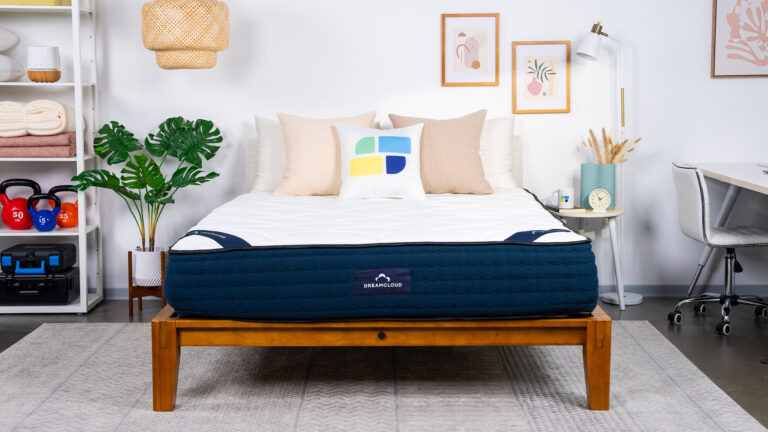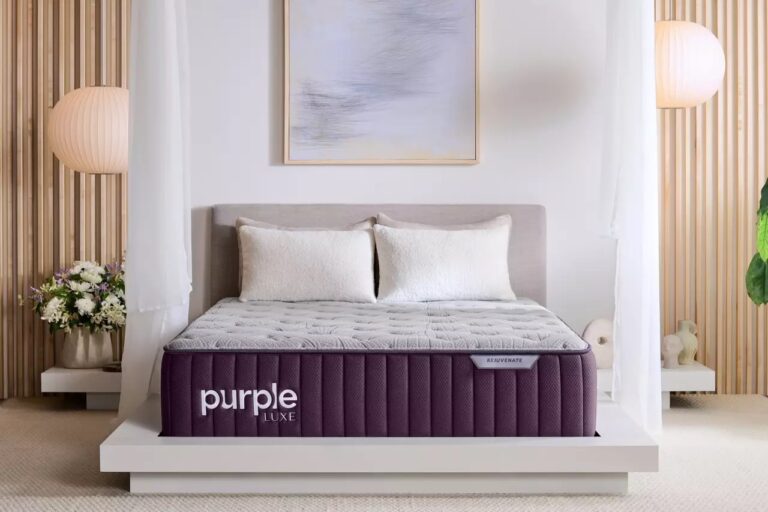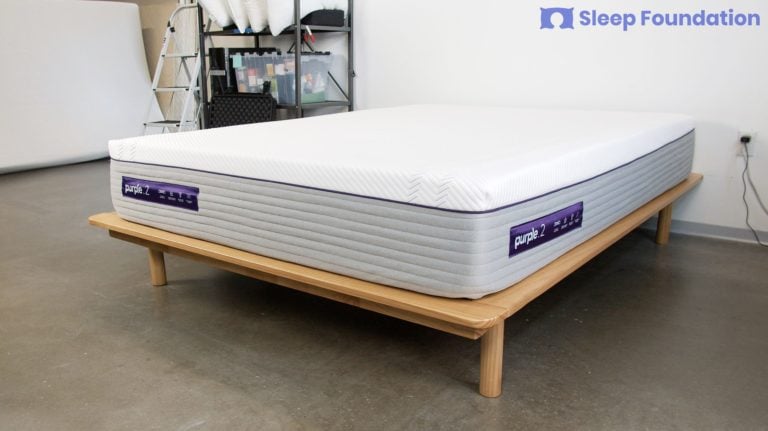When you buy through our links, we may earn a commission. Products or services may be offered by an affiliated entity. Learn more.
DreamCloud vs. Purple Mattress Comparison

DreamCloud Memory Foam Mattress
Bottom Line
An affordable all-foam mattress that excels at pressure relief, motion isolation, and support for side sleepers.
50% off mattresses + $599 worth of free accessories
Full Mattress ReviewVS

Purple Mattress
Bottom Line
A unique mattress with a polymer grid that makes for a close-conforming, bouncy, breathable surface like no other.
$1,399 from Purple (queen)
Full Mattress ReviewDreamCloud and Purple are mattress manufacturers that sell their products both online and in select brick-and-mortar stores. Purple started up in 2015 and DreamCloud wasn’t far behind with their 2018 launch date. Purple’s product line includes all-foam and hybrid models that feature the company’s Purple Grid system. DreamCloud also sells a full range of mattresses including all-foam and hybrid models at multiple price-points.
We’ll take a close look at the companies’ flagship beds, the Purple Mattress and the DreamCloud Mattress. The Purple Mattress is all-foam, while the DreamCloud Mattress comes in all-foam and hybrid constructions. While we’ve included some details about the DreamCloud hybrid model, our comparison focuses on the DreamCloud Memory Foam Mattress, as it’s more similar to the Purple Mattress.
We’ll explain how these beds compare against one another in some of the most crucial factors for customers, including support, comfort, price, and overall performance. You’ll learn which mattress is better suited to your needs and find out how each model scored during our testing trials.
Quick Look
$765
$1,099
Medium Firm (6)
Medium Firm (6)
- Conforming comfort layers balance out the strong coil system
- Excellent motion isolation for couples
- Signature comfort layer contours and relieves pressure without too much sink
- Exceptional breathability and temperature control
- 365 nights (30-night requirement)
- Lifetime, limited
- 100 nights (21-night requirement)
- 10 Year, Limited
- A+
- A+
Our Testing Team’s Take
In order to determine which mattresses are the best, we evaluate them in our Seattle Test Lab and at home. In the lab, we test every model against the same standards to see how they stack up against each other in important performance categories like temperature regulation, pressure relief, and motion isolation.
We also sleep on each mattress in our own bedrooms to see how they feel for real people. Our testers represent a wide range of sleep positions and body weights, allowing us to evaluate mattresses for different sleeper types. Using this data, we give each mattress an overall score.
Our Verdict
If you’re a back sleeper or side sleeper under 230 pounds, there’s a good chance you’ll like the DreamCloud Memory Foam Mattress, the Purple Mattress, or both. They’re effective at relieving pressure and their medium firm (6) feels offer a nice blend of structure and support for people who like a balanced-feeling mattress. Couples who want motion isolation may also want to give one of these mattresses a try.
Because they have similar pros, picking between these mattresses comes down to what you’re willing to spend, what you’re not willing to sacrifice, and which firmness level you prefer.

Mary Fenton
Head of Product Content
Combo sleeper
150 lbs.
Sleeps with a noise machine
“I was excited to try Dreamcloud’s all-foam model after hearing a lot of great things about it. Upon first laying on it, I had to triple check that it wasn’t the hybrid model because it had that initial give of memory foam but still felt really supportive at its core. I move around a lot during the night and found it to be really forgiving from that aspect, even along the perimeter. It was maybe a teeny bit firm initially for my liking, but I found myself favoring this bed to other softer models after just a few nights.”
The Purple Mattress begins with the signature Purple Grid comfort layer. This material feels a little floatier than traditional memory foam, though its unique feel can take some getting used to. The DreamCloud feels more like what you’d expect from an all-foam mattress – compressive, adaptive, and body-hugging.
The Purple Sleeps cooler than the DreamCloud Memory Foam Mattress. One of the biggest differences between the Purple and DreamCloud is cost – you’ll pay nearly twice as much for the Purple.
Consider your budget, sleeping position, and non-negotiables when choosing a new mattress.

Jeremy Klein
Senior Product Testing Manager
Side sleeper
160 lbs.
Nightly melatonin user
“The Purple’s unique “grid” design really sets it apart from traditional all-foam beds on the market. As someone who sleeps hot and enjoys deep cushioning, this mattress nicely checks both boxes.”
Construction and Materials
Though the DreamCloud Memory Foam Mattress and the Purple Mattress are both mattress-in-a-box models with foam comfort layers, there are differences in their materials. Learn about their constructions in the table below.
| Construction Analysis | DreamCloud Memory Foam Mattress | Purple Mattress |
|---|---|---|
| Cover | Cashmere blend | Viscose, polyester, Lycra spandex |
| Comfort Layer | Gel-infused memory foam and polyfoam (quilted to cover) 2” gel-infused memory foam | 2” buckling column gel |
| Transitional Layer | 1” polyfoam | 3.25″ polyfoam |
| Support Core | 9” polyfoam | 4″ polyfoam |
DreamCloud Memory Foam Mattress Breakdown
The DreamCloud Memory Foam Mattress is a medium firm (6) model. It begins with a pillow-top that’s quilted with two types of foam, gel-infused memory foam and polyfoam.
These materials give the bed a plush and supportive feel. A third comfort layer consists of gel-infused memory foam that adapts to your body, relieving pressure without retaining as much heat as traditional memory foam.
The 1-inch transitional polyfoam layer aims to disperse weight evenly while maintaining even spinal support. The 9-inch polyfoam support core gives the mattress its structure and it creates a stable sleep surface. The upper cover is a soft, cashmere blend fabric, while the lower is a shift-resistant fabric to prevent the mattress from moving on its foundation.
Purple Mattress Breakdown
The three-layer Purple Mattress has a more streamlined construction than the DreamCloud Mattress. It has a medium firm (6) firmness level and measures 9.25 inches tall. The top layer is made of Purple’s signature GelFlex Grid, a hyper-elastic polymer molded into a grid shape. The material is designed to act like memory foam while reducing heat retention. Standard foam around the grid’s perimeter helps reduce sinkage along the edges.
Under the 2-inch GelFlex Grid, a 3.25” polyfoam layer adapts to the body’s shape and aligns the spine to minimize back pain. The support core is 4 inches of high-density polyfoam that’s structured and formulated to reduce bounce and minimize motion transfer across the surface. The stretchy polyester, viscose, and Lycra spandex blend cover is made to work seamlessly with the GelFlex Grid.
Mattress Sizing and Weight
The DreamCloud Memory Foam is 12 inches tall, while the Purple is 9.25 inches. Though it’s a few inches shorter, the Purple Mattress outweighs the DreamCloud by about 30 pounds, which is something to consider during installation. You can buy these mattresses in the same sizes: twin, twin XL, full, queen, king, California king, and split king.
| Model | Profile | Weight (Queen) |
|---|---|---|
| DreamCloud Memory Foam Mattress | 12″ | 78 lbs. |
| Purple Mattress | 9.25″ | 110 lbs. |
Performance Ratings
The Purple Mattress and DreamCloud Memory Foam Mattress both relieve pressure and isolate motion extremely well, which isn’t surprising when you consider their thick foam comfort systems. If you experience joint pain or pressure points, or you’re a light sleeper who wakes easily from movement, either of these beds should be an excellent option.
However, foam has its drawbacks. Both beds have fairly restrictive sleep surfaces, especially compared to hybrids and innersprings. That’s not a dealbreaker for everyone though, so if you like a bed with an adaptive feel, you’ll probably like either of these. The Purple has more airflow than the DreamCloud and it’s a worthy option for a cooling mattress if you sleep hot but you like foam’s feel.
According to our testing team, the Purple Mattress is ideal for side and back sleepers between 130 and 230 pounds. Side sleepers in this weight range liked the DreamCloud too, as did back sleepers under 130 pounds. The stomach sleepers and people over 230 pounds who tested these beds thought that they lacked the support they needed.
Mattress Pricing
Though there are exceptions, most memory foam mattresses cost between $700 and $1,200 for a queen size. The DreamCloud Memory Foam Mattress sits at the low end of this spectrum, while the Purple Mattress costs significantly more.
Despite its more affordable price tag, the DreamCloud Mattress has a longer sleep trial and warranty than the Purple Mattress. During durability testing, these mattresses both got scores indicating they should last up to or slightly beyond the average lifespan of a foam mattress.
| Policy | DreamCloud Memory Foam Mattress | Purple Mattress |
|---|---|---|
| Sleep Trial | 365 nights | 100 nights |
| Warranty | Lifetime, limited | 10 year, limited |
| Shipping | Free to contiguous U.S. | Free to contiguous U.S. |
| White Glove Delivery | Available for an added fee | Not available |
What Customers Are Saying
Hot sleepers who own the Purple Mattress say it stays cool through the night. Owners also say that the mattress is durable and feels responsive, but not too bouncy. Some reviewers report that the grid system can take some getting used to and that it’s somewhat noisy.
DreamCloud owners like how luxe the mattress feels, especially considering its affordability. It also gets strong reviews for edge support and pressure relief, with users noting how comfortable its foam feels. Certain reviews indicate that the foam may compress and become indented over time.

Still have questions? Ask our community!
Join our Sleep Care Community — a trusted hub of product specialists, sleep health professionals, and people just like you. Whether you’re searching for the perfect mattress or need expert sleep advice, we’ve got you covered. Get personalized guidance from the experts who know sleep best.







